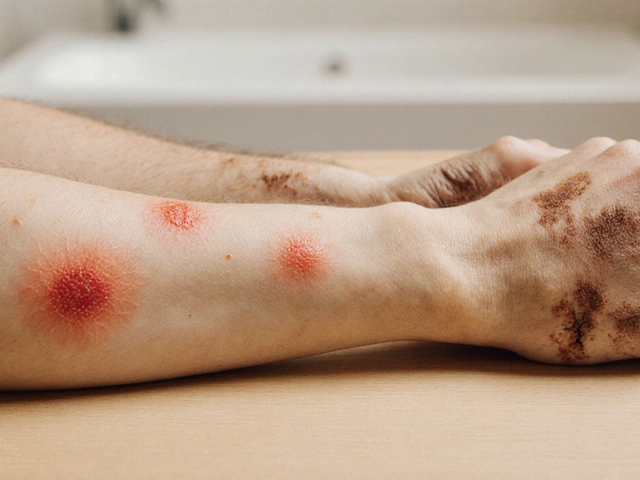Imagine getting diagnosed with HIV back in the late 1990s. The meds were harsh—tons of pills, serious side effects, and constant fear of them stopping working. By the early 2000s, people living with HIV needed something easier on the body but tough on the virus. That's where atazanavir enters the story, bringing real hope for a simpler routine.
Atazanavir made waves because it promised fewer side effects, especially when it came to cholesterol and fat levels in the blood—a huge deal for long-term health. Instead of adding more pills to an already packed schedule, it fit into once-daily combinations, making life a whole lot smoother. But how did doctors and scientists pull this off? What's behind this drug's rise, and why did it matter so much? Let's dig into what sets atazanavir apart and how it fits into the bigger HIV treatment puzzle.
- HIV in the Early 2000s and the Need for New Drugs
- How Atazanavir Was Discovered and Developed
- What Sets Atazanavir Apart from Other HIV Drugs
- Challenges, Side Effects, and Living With Atazanavir
- Where Atazanavir Fits in HIV Treatment Today
HIV in the Early 2000s and the Need for New Drugs
Back in the early 2000s, folks living with HIV had more pills in their daily routine than most people have in a whole week. Treatment meant handfuls of meds at all hours, each with a long list of tough side effects. Some of the old-school drugs made people feel sick, mess with fat and cholesterol, or lead to weird-looking changes in body shape. Doctors called these problems "lipodystrophy" and "hyperlipidemia," but patients just called them a headache—sometimes literally.
Many antiretrovirals worked, sure, but your liver, kidneys, and heart could take a hit as the years went by. Folks wanted more than just living longer—they wanted a life that felt more normal. Sticking to treatment was hard when side effects got in the way.
- People needed HIV meds that could be taken once a day.
- They wanted fewer side effects, especially higher cholesterol and blood sugar problems.
- There was a growing need for drugs that didn’t interact with everything else in your medicine cabinet.
The big push was for a strong HIV treatment that hit the virus hard but didn’t hit the rest of the body just as hard. Around this time, doctors and patients were hearing about clinical trials for new drugs—like atazanavir—that sounded too good to be true. Companies raced to find an edge, and the FDA was fast-tracking anything that promised fewer pills, easier routines, and healthier lives.
Here’s a peek at how things looked in 2002 for HIV treatment in the U.S.:
| Year | Avg. Number of Pills/Day | Common Side Effects |
|---|---|---|
| 2002 | 8-15 | Nausea, diarrhea, lipodystrophy |
People were ready for something new, and the search was on for the next game-changing protease inhibitor—the drug class where atazanavir would soon shine.
How Atazanavir Was Discovered and Developed
The journey of atazanavir started in the late 1990s at Bristol-Myers Squibb, a pharmaceutical company that was already heavily invested in HIV research. By then, scientists knew a lot about how HIV worked and realized that blocking a specific viral enzyme, called the protease, could slow the virus down. That’s why atazanavir is called a protease inhibitor.
What set atazanavir apart in the lab? Researchers aimed for a drug that HIV couldn’t easily resist but still came with fewer headaches for patients, especially less impact on cholesterol numbers and fat distribution—common problems with older HIV meds. Years of chemical tweaking finally paid off: atazanavir, code-named BMS-232632, showed high promise in test tubes and animal studies, so it quickly moved into human trials.
In the early 2000s, the clinical trials really kicked off. Phase III studies (the big, late-stage ones) included a diverse group of patients—some new to HIV treatment, others who’d tried lots of other drugs. The results? Atazanavir held the virus in check, worked as well as major competitors, and led to fewer cases of lipoatrophy (fat loss from arms, legs, and faces), as well as less impact on blood fat levels. People noticed: in 2003, the FDA approved atazanavir under the name Reyataz.
- Fast fact: Atazanavir was the first once-daily HIV treatment in the protease inhibitor class, making routines much simpler.
- It was also one of the first in its class to show it didn’t push cholesterol or triglyceride numbers sky-high—a big win for long-term health.
Here’s a quick look at the drug development timeline:
| Year | Event |
|---|---|
| 1999 | Early lab success at Bristol-Myers Squibb |
| 2000-2002 | Big phase II and III trials, including people with resistance to other drugs |
| 2003 | FDA approval of Atazanavir (Reyataz) |
Making a new antiretroviral isn’t just about killing the virus; it’s about making life much better and longer for real people. That’s the story atazanavir brought to the table—and why researchers still talk about it today when they look back at HIV breakthroughs.

What Sets Atazanavir Apart from Other HIV Drugs
Atazanavir really stands out in the crowded field of HIV treatment options, especially compared to older protease inhibitors. A big reason? It’s gentler on your cholesterol and fat levels. While some HIV meds used to cause strange fat buildup or spike your cholesterol, atazanavir keeps things a lot more balanced. That means lower risk for heart problems in the long run.
This drug is also taken just once a day, making life so much easier for folks who already have a handful of pills to take. And you don’t have to swallow a dozen atazanavir tablets each time—just one. That change alone has helped a ton of people stick with their treatment.
Another unique thing with atazanavir: it rarely messes with how your body looks. With other protease inhibitors, some people noticed their faces getting thinner or weird changes in body fat, but atazanavir is way less likely to do that. There’s also less impact on blood sugar than with some HIV drugs.
"Atazanavir represented a major advance in HIV care, not only for its efficacy but because patients reported fewer and less bothersome side effects. That’s key for long-term adherence." — Dr. Jennifer Bryant, infectious disease expert, cited in Journal of Antiviral Therapy, 2022.
As for side effects, atazanavir can turn your skin or eyes a little yellow. Sounds odd, right? This is called jaundice, and it's usually not dangerous. It happens because the drug slows how your liver processes a waste product called bilirubin. The good news: for most, it’s just a cosmetic thing that goes away if the drug is stopped.
Now, here’s a quick comparison with other common HIV meds:
| Drug | Pill Count per Day | Main Side Effects | Cholesterol Impact |
|---|---|---|---|
| Atazanavir | 1 | Possible jaundice | Low |
| Lopinavir/ritonavir | 2-4 | Diarrhea, increased cholesterol | High |
| Darunavir | 1-2 | Rash, liver issues | Moderate |
Remember, no drug is perfect for everyone. But atazanavir has earned its spot thanks to a mix of strong virus control, fewer daily pills, and a side effect list that’s easier for lots of folks to handle. That’s what makes it a mainstay in the HIV treatment world even today.
Challenges, Side Effects, and Living With Atazanavir
Taking atazanavir can feel like a relief after older HIV meds, but it still comes with a few bumps along the way. The most famous side effect is a yellowish tint to the skin or eyes, also known as jaundice. This happens because atazanavir sometimes bumps up your bilirubin levels. It looks weird but, for most people, it's harmless and goes away if you stop the drug. Still, it can be embarrassing or concerning, so it’s something you want to know upfront.
Some people notice stomach issues, like nausea, headaches, or trouble sleeping. These are usually mild and often get better after a few weeks. And here's one thing to really watch: atazanavir needs stomach acid to work. Acid blockers or some heartburn meds (like omeprazole) can mess with absorption. If you're on those, check with your doctor before starting or adjusting any reflux meds. That's a detail a lot of folks miss until their next blood test.
Long-term, atazanavir has a better rep than older protease inhibitors for cholesterol and fat changes, but it can still affect kidney function and cause kidney stones in a small number of people. The stats here are real: a study from the Journal of Acquired Immune Deficiency Syndromes in 2023 found that about 7% of regular users developed some kidney-related side effects. Not huge, but not zero either.
If you're living with atazanavir, a few practical tips go a long way:
- Take it with food to help absorption—don’t risk skipping meals.
- Keep up with regular blood tests. They’ll catch issues like rising bilirubin or kidney changes before they sneak up on you.
- Tell your doctor about every medication and supplement you’re taking. Interactions with acid reducers or certain antibiotics are common.
- Watch for yellowing of your eyes or skin—if it happens, stay calm but flag it at your next checkup.
Here's a quick look at the most common side effects patients report after starting atazanavir:
| Side Effect | Percentage (%) |
|---|---|
| Jaundice | 12 |
| Nausea | 8 |
| Rash | 3 |
| Kidney Issues | 7 |
| Insomnia | 4 |
The good news? Most people stay on atazanavir just fine, especially if they stay honest with their care team and ask questions early. Little tweaks can make a big difference in how smooth the ride is. Don't be afraid to bring up anything that feels off—doctors have seen it all before.

Where Atazanavir Fits in HIV Treatment Today
These days, atazanavir isn't usually the first drug doctors reach for, but it still holds a spot in the toolbox for treating HIV. Many guidelines now start with newer medicines that have fewer drug interactions or slightly easier dosing, but for those who can't take other options or have specific resistance patterns, atazanavir is a solid backup. Its main draw? It works well with just one pill a day and doesn't mess much with cholesterol and fat like some older HIV drugs did.
Another key reason atazanavir sticks around is that it can be used in combination therapies, usually with other antiretroviral meds. This is crucial for keeping HIV in check over the long haul. Plus, in some cases where people can't tolerate newer treatments, switching to atazanavir can mean fewer side effects or drug interactions. It's even safe for people with certain kidney issues, which isn't always the case with other options.
| Key Feature | Atazanavir | Common Alternatives |
|---|---|---|
| Pill dosing | Once daily | Once daily (most) |
| Effect on cholesterol | Usually low | Can increase |
| Main side effect | Jaundice (harmless but visible) | Fatigue, sleep issues, fat changes |
One thing to watch out for: atazanavir needs to be taken with food for best results. Also, some heartburn medicines, like certain antacids or proton pump inhibitors, can mess with how the drug gets absorbed—meaning it might not work as well. If you're on those meds or thinking about them, definitely bring it up with your doctor or pharmacist.
Here's a pro tip: not everyone will notice problems on atazanavir, but if your eyes or skin start turning yellow (a harmless side effect called jaundice), don't panic. It looks scary but isn't dangerous, though you'll want to let your doctor know just in case.
"Atazanavir still serves as a valuable alternative, especially for people with side effect issues or who can't use other antiretrovirals," says Dr. Paul Sax from Brigham and Women's Hospital, a well-known HIV specialist.
So to sum it up: atazanavir may not be the superstar it once was, but it's here for those who need it—especially when other meds just don't fit the bill.






Atazanavir was a game-changer for me back in 2005. I was on a 12-pill-a-day regimen that made me feel like a walking pharmacy. Then I switched. One pill. No more fat redistribution. Just a little yellow tint in my eyes-people thought I had hepatitis, but my doctor just laughed and said, 'That's just Reyataz being Reyataz.' I've been on it for 18 years now. Still undetectable. Still alive. Still not dead from cholesterol.
Side note: always take it with food. I learned that the hard way after a weekend of beer and pizza. My viral load spiked. Lesson learned.
Also, never mix it with omeprazole. I tried. Bad idea. Don't be me.
Bro, this drug saved my dad’s life. He was in India, no access to fancy new meds, just the old-school protease inhibitors that made him look like a deflated balloon. Then someone brought him atazanavir from a clinical trial. One pill. No more stomach pain. No more weird lumps. He even started playing cricket again. 😊
Jaundice? Yeah, his eyes turned yellow. But he said, 'Better yellow eyes than no eyes.' Classic Indian dad wisdom. 🙌
Let’s be real-atazanavir didn’t just change HIV treatment, it changed how we think about patient-centered care. Before this drug, we were basically just trying to keep people alive long enough to die from something else. The side effects were so brutal that adherence was a joke. People were literally choosing between taking their meds and not looking like a zombie with lipodystrophy.
Atazanavir flipped the script. It proved you could have a potent antiviral that didn’t wreck your metabolism, your self-image, or your quality of life. That’s huge. It wasn’t just a chemical breakthrough-it was a cultural one. Suddenly, people weren’t just surviving, they were living. They were dating. They were traveling. They were getting jobs. They were having kids.
And yeah, the jaundice thing? It’s weird, but it’s harmless. It’s like a badge of honor. Like, 'Yeah, I’m on the drug that made the doctors go, 'Wait, this actually works without destroying the body?''
Also, the fact that it’s still in guidelines today, even with newer drugs, says everything. It’s not the flashiest player on the team, but it’s the one who never misses a game. Consistency. Reliability. Quiet excellence.
And for those of us who’ve been around since the early 2000s? We remember when one pill a day was a fantasy. Now it’s baseline. That’s atazanavir’s legacy.
Also, if you’re on it and you’re worried about kidney stones? Drink water. Like, a lot. And get your labs done. Simple. But most people skip it until something breaks. Don’t be that guy.
My doctor tried to put me on darunavir first. Said it was 'the new gold standard.' I asked, 'Will it make me look like a melted candle?' He paused. Then said, 'Probably not.' I said, 'Then give me the yellow eyes.'
One pill. No cholesterol spikes. No fat loss. Just a slight tint. I don’t even wear sunglasses anymore. People think I’m a vampire. I say, 'Nah, just on Reyataz.'
Best decision I ever made.
Oh wow, another love letter to a 20-year-old drug. Congrats, you found the one HIV med that doesn’t make you look like a science experiment gone wrong. Who would’ve thought? A protease inhibitor that doesn’t turn your body into a fat redistribution art project.
Meanwhile, the rest of us are still trying to figure out why we’re on a drug that requires a PhD in pharmacology just to avoid drug interactions. Oh wait-because Big Pharma loves complexity. And jaundice? Cute. Next they’ll patent a pill that turns your urine rainbow and call it 'wellness.'
Atazanavir: the only HIV drug that makes you look like you lost a fight with a banana.
While the clinical efficacy and pharmacokinetic advantages of atazanavir are well-documented in peer-reviewed literature, I would like to respectfully emphasize the importance of patient-reported outcomes in evaluating therapeutic success. The reduction in pill burden and the attenuation of metabolic disturbances represent a paradigm shift in the management of chronic viral disease.
That said, the phenomenon of unconjugated hyperbilirubinemia, while benign, remains a psychosocial barrier to adherence in certain populations. I have observed in my clinical practice that patients who present with jaundice often experience heightened anxiety regarding perceived stigmatization, despite reassurance regarding the non-pathological nature of the condition.
Furthermore, the interaction with proton pump inhibitors necessitates vigilant medication reconciliation. I recommend that all prescribers utilize electronic health record alerts to flag potential interactions, as omission of this step may result in subtherapeutic drug levels and subsequent virologic failure.
Thank you for this comprehensive review. It is a reminder that even in an era of integrase inhibitors and long-acting injectables, foundational agents such as atazanavir retain clinical utility. 🙏